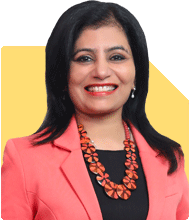42-Year-Old Man with 150L Assets: Am I on Track to Retire Comfortably?
Ramalingam Kalirajan |8077 Answers |Ask -Follow
Mutual Funds, Financial Planning Expert - Answered on Aug 23, 2024
He has an MBA in finance from the University of Madras and is a certified financial planner.
He is the director and chief financial planner at Holistic Investment, a Chennai-based firm that offers financial planning and wealth management advice.... more

Hi Sir, I am 42 year male married and have sons aged 15 and 8. My current financial status are: Debt free. 1 apartment 50L, 1 land 10L, MFs 60L, FD 30L, PF 20L, one time LIC investment 10L, Term Insurance cover of 2C, Medical Insurance cover 10L. I continue to invest 50k per month in MF thru SIP. I wish to retire in 10-12 years. Considering inflation i wish to get 2L per month post retirement. Plz advice if i am on right track.
Debt-Free Status: You have no liabilities, which is an excellent starting point.
Assets:
Apartment worth Rs. 50 lakhs
Land worth Rs. 10 lakhs
Mutual Funds (MFs) worth Rs. 60 lakhs
Fixed Deposit (FD) worth Rs. 30 lakhs
Provident Fund (PF) worth Rs. 20 lakhs
One-time LIC investment of Rs. 10 lakhs
Insurance:
Term Insurance cover of Rs. 2 crores
Medical Insurance cover of Rs. 10 lakhs
Ongoing Investments:
Monthly investment of Rs. 50,000 in Mutual Funds through SIP.
Retirement Planning: Assessing Your Goals
You wish to retire in 10-12 years, targeting a post-retirement income of Rs. 2 lakhs per month, adjusted for inflation. Achieving this goal requires strategic planning and disciplined investing.
Let’s break down the key aspects to consider:
1. Understanding Inflation's Impact
Inflation: Over the next 10-12 years, inflation will erode the purchasing power of money.
Current Goal: Rs. 2 lakhs per month.
Future Value: At a 6% inflation rate, Rs. 2 lakhs today might equate to roughly Rs. 4-4.5 lakhs per month by the time you retire.
2. Current Investment Review
Mutual Funds:
With Rs. 60 lakhs currently invested and Rs. 50,000 added monthly, you’re building a significant corpus.
Continue with diversified equity mutual funds for growth. This approach is ideal for long-term wealth creation.
Fixed Deposits:
Rs. 30 lakhs in FDs is a safe, conservative investment.
However, the returns may not outpace inflation. Consider reducing FD allocation in favour of debt mutual funds or other higher-yield options.
Provident Fund:
Rs. 20 lakhs in PF is a stable, long-term investment.
This corpus will be a reliable part of your retirement fund.
LIC Investment:
The one-time investment of Rs. 10 lakhs in LIC is relatively small in comparison to your overall portfolio.
Evaluate its performance and consider if reallocation might provide better returns.
3. Income Generation Post-Retirement
Systematic Withdrawal Plans (SWPs):
Upon retirement, converting a portion of your mutual fund investments into SWPs can provide a steady income.
This will help you withdraw Rs. 2 lakhs or more per month.
Equity-Debt Rebalancing:
Gradually shift your equity investments towards debt as you approach retirement.
This will reduce risk and provide stability in your income.
Dividends and Interest:
Consider dividend-yielding stocks or mutual funds to generate regular income.
FDs can also provide periodic interest payments, although the returns may be lower.
4. Education and Marriage Planning for Children
Higher Education Fund:
Your sons, aged 15 and 8, will require funds for higher education soon.
Start allocating a portion of your savings or new investments towards a dedicated education fund.
Marriage Fund:
Although marriage might be a longer-term goal, consider starting a small SIP to build a corpus over time.
5. Insurance and Healthcare Needs
Term Insurance:
Your Rs. 2 crore term insurance is adequate for now.
Ensure it covers your family’s future financial needs.
Health Insurance:
Rs. 10 lakhs cover may need a top-up as medical costs rise.
Consider increasing your medical insurance or creating a medical emergency fund.
6. Reviewing and Adjusting Your Portfolio
Annual Review:
Conduct an annual review of your investments to ensure they align with your goals.
Rebalance your portfolio to maintain the desired asset allocation.
Professional Guidance:
A Certified Financial Planner can help refine your strategy as you near retirement.
They can ensure that your investments remain on track.
Final Insights
You are on the right track, but achieving Rs. 2 lakhs per month post-retirement will require continued discipline and possible adjustments to your strategy. Focus on growing your corpus, protecting it from inflation, and ensuring that you are prepared for your children’s education and future healthcare costs. Regular reviews and timely adjustments will help you meet your retirement goals comfortably.
Best Regards,
K. Ramalingam, MBA, CFP,
Chief Financial Planner,
www.holisticinvestment.in
You may like to see similar questions and answers below
Ramalingam Kalirajan |8077 Answers |Ask -Follow
Mutual Funds, Financial Planning Expert - Answered on Apr 17, 2024
Milind Vadjikar |1086 Answers |Ask -Follow
Insurance, Stocks, MF, PF Expert - Answered on Oct 11, 2024
Milind Vadjikar |1086 Answers |Ask -Follow
Insurance, Stocks, MF, PF Expert - Answered on Oct 17, 2024
Archana Deshpande |103 Answers |Ask -Follow
Image Coach, Soft Skills Trainer - Answered on Mar 05, 2025
Archana Deshpande |103 Answers |Ask -Follow
Image Coach, Soft Skills Trainer - Answered on Mar 04, 2025
Archana Deshpande |103 Answers |Ask -Follow
Image Coach, Soft Skills Trainer - Answered on Mar 04, 2025
Dr Dipankar Dutta |909 Answers |Ask -Follow
Tech Careers and Skill Development Expert - Answered on Mar 04, 2025
Dr Dipankar Dutta |909 Answers |Ask -Follow
Tech Careers and Skill Development Expert - Answered on Mar 04, 2025
Dr Dipankar Dutta |909 Answers |Ask -Follow
Tech Careers and Skill Development Expert - Answered on Mar 04, 2025
Dr Dipankar Dutta |909 Answers |Ask -Follow
Tech Careers and Skill Development Expert - Answered on Mar 04, 2025
Dr Dipankar Dutta |909 Answers |Ask -Follow
Tech Careers and Skill Development Expert - Answered on Mar 04, 2025
Prof Suvasish Mukhopadhyay |458 Answers |Ask -Follow
Career Counsellor - Answered on Mar 04, 2025
Prof Suvasish Mukhopadhyay |458 Answers |Ask -Follow
Career Counsellor - Answered on Mar 04, 2025




















